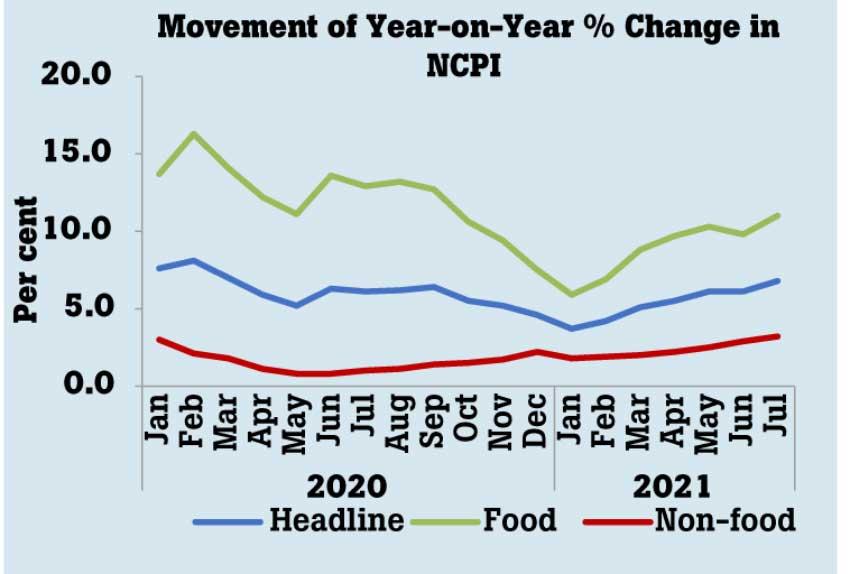25 Aug 2021 - {{hitsCtrl.values.hits}}

National consumer prices rose to 16-month high in July as food prices soared while non-food prices gained over the previous month with the brief returning of normalcy after month long virus-related restrictions in June, as seen from the subcategories of transport, clothing and restaurant dining.
The inflation measured by the National Consumer Price Index (NPI) rose by 6.8 percent in the twelve months to July 2021 from 6.1 percent in June as people were forced to spend more on their basic food staples to travelling to clothing to other outdoor activities from a year earlier levels.
The last time the national consumer prices went beyond this level was in March 2020 when such prices rose by 7.0 percent year-on-year (YoY), i.e. even before the full effects of the pandemic and the monetary and fiscal stimulus had any impact on prices.
Inflation became a hot-button issue, not just domestically but globally after central banks and governments unleashed extraordinary stimulus programmes since the onset of the pandemic
last year,
flushing the global markets with liquidity, causing global commodities prices to rise and global supply chains to snarl amid spurt in demand with the re-opening of economies after remaining closed for months.
Exacerbating the conditions, Sri Lanka experienced disruptions to its food supply chains due to virus-related restrictions in May and June, tightened import restrictions and weaker rupee against the dollar, forcing people to pay even higher prices for all its imported commodities.
Some argue that the record liquidity injections by the Central Bank since March last year are also a main reason for the increase in domestic prices.
While the Central Bank is yet to think so, it last week tightened the monetary policy to preempt any potential persistent increase in prices as they feared some of the higher global commodities prices to remain until th global demand conditions dissipate with the gradual roll back of the stimuli.
In July, the national food prices surged 11.0 percent YoY accelerating from 9.8 percent in June, but the month-on-month (MoM) price increase eased to 0.8 percent from 2.6 percent in June, signalling some comfort that the MoM prices are easing.
But the continuation of the trajectory remains uncertain with fresh restrictions imposed on the economy to arrest the fast spreading virus again.
The prices of many commodities including rice, sugar, vegetables, dried fish, fresh fish, eggs, chicken, Mysore dhal and a few others rose while the prices of coconuts, coconut oil, big onions, red onions and green gram eased from June.
Meanwhile, non-food prices accelerated to 3.2 percent YoY in July 2021 from 2.9 percent, while such prices also rose on MoM basis by 0.5 percent from 0.4 percent in June, reflecting a brief returning to normalcy after the end of lockdowns and easing of restrictions on other outdoor and recreational activities amid the effects of the June revision in fuel prices still being permeated through the rest of the economy.
This is reflected from the increase in prices in subcategories of travelling, clothing, restaurants and hotels and recreational and other cultural activities, such as weddings and other events which briefly returned in July.
Meanwhile, the so-called national core prices measured barring the often-volatile items such as food, energy and transport, rose by 4.4 percent YoY in July, up from 4.1 percent in June.
The Central Bank remains confident that headline prices in the Colombo district measured by the Colombo Consumer Price Index could be maintained close to the upper bound of their desired range of 4 - 6 percent by the year end.
In July, Colombo prices rose by 5.7 percent from a year ago from 5.2 percent in June.
18 Nov 2024 9 minute ago
18 Nov 2024 44 minute ago
18 Nov 2024 45 minute ago
18 Nov 2024 1 hours ago
18 Nov 2024 1 hours ago